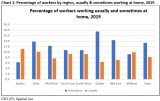Introduction
In a recent blogpost I examined the data on working from home and the trends that have occurred up to the outbreak of the Covid-19 pandemic. The data over the last two decades suggest that there may be a correlation between economic growth, unemployment levels and the numbers working from home. So, for example, as the unemployment rate declined the percentage engaged in working from home increased. When unemployment was at its lowest, in 2019 at 5%, the percentage working from home was at its highest at approximately 20% nationally, see here.
In this blogpost I examine previously unpublished data to see if there are regional differences. Are there regional patterns? Are there different levels of working from home in more urban or rural regions or those regions considered ‘commuter regions’ such as the Mid-East?
Labour Force Survey: Working Sometimes or Usually from Home
The CSO Labour Force Survey asks how often did you work at home. If the response is that you worked for at least one hour from home in the last four weeks then it is categorised as ‘sometimes works from home’. If the respondent reports that ‘At least half of the days worked at home’, then the response is categorised ‘as usually works from home’.
Examining both these groups to capture all those who work from home; nationally over a fifth of the population (21.5%), report sometimes or usually works from home. These data include all sectors (including Agriculture, Forestry and Fishing). Note the data reported in the previous blogpost see here, reported a slightly lower working from home rate of 20%, but this excluded the Agriculture, Forestry and Fishing sector[1].
In 2019, all regions report greater levels of working from home than in 2012, see Table 1 below. In 2019, two regions have levels above the national average (Dublin and the West region), both at 23.9%. This is followed by the Mid-East region (21.4%), followed by the South-East and South West regions, both with 20% working sometimes or usually from home. The regions with the lowest rates in 2019 are the Midland region (19.1%) and the Border region (17.3%).
As noted in the previous blog post, the trend in the national rate had been downward from 2012 through to 2014 with an upward trend in the latter half of the period to 2019, coinciding with rising employment levels and reduced unemployment. This pattern is also generally evident across most regions with the exception of the Midland region which has experienced a continuous upward trend.

Geographic Differences between Sometimes and Usually working from Home
Combining the categories of ‘sometimes’ and ‘usually’ working from home captures all those working from home but a closer look at the data highlights important differences. The chart below depicts those who sometimes and those who usually work from home in 2019 by region. It is clear that there are regional differences. It is also clear that there is a different regional pattern when examining the separate categories of usually and sometimes working from home.

So for example, those regions with the highest rate of sometimes working from home such as Dublin and the Mid-East are those regions with the lowest rate who usually work from home. Conversely those regions with some of the highest rates working usually from home (the Border and Midlands regions) are those regions with the lower rates of usually working from home. The West region is somewhat of an exception here with relatively high rates of both usually and sometimes working from home.
Examining the separate groups in more detail, it is worth repeating the definitions;
- those who usually work from home are those who report having worked ‘At least half of the days worked at home’.
- those categorised as sometimes works from home are those who have worked for ‘at least one hour from home in the last four weeks’.
Usually working from home
It is likely that those who usually work from home include those engaged in Agriculture and others who are self-employed and largely home based, for example home-based sole traders and self-employed such as GPs, childminders and construction workers. Previous work by the WDC Policy team have noted the relatively high rates of self-employment in more rural areas. A blogpost on Census data, see here notes the very strong spatial pattern to self-employment with the most rural counties having higher rates than the state average of 15.6%. For example, five of the Western Region counties are in the top ten nationally in terms of share of self-employment, Leitrim (20.3%), Roscommon (19.9%), Mayo (19.6%), Galway county (19.5%) and Clare (19.5%) all having in excess of or close to 1 in 5 of their workers self-employed.
As that analysis notes, the strong spatial pattern of self-employment in Ireland is related to many factors but notably the sectoral and occupational pattern of employment. Apart from Agriculture and Construction, the relative lack of alternative employment opportunities, especially in the more remote rural areas, means that more people choose (or are necessitated) to turn to self-employment. Table 2 below shows the percentage of employment by region, usually working at home over the period 2012-2019.

The data certainly supports the rural/urban pattern with higher rates of those usually working from home in the more rural regions, such as the Border and West regions, while the more urban region of Dublin has the lowest rate of 6.4% in 2019.
The trend nationally has also shown a decline from 2012 to 2016 with an increase thereafter. This suggests that there is also some relationship with higher employment levels and low unemployment rates in 2019. This trend is also clear across every region, albeit with different levels in each, see table 2 above.
Sometimes working from home
Those categorised as sometimes working from home are those who have worked for at least one hour from home in the last four weeks. In 2019 the national average was 13.3%, with Dublin, the Mid-East and West regions having higher than average rates. The lowest rates are in the Border and Midland regions. This suggests that both opportunity (employers who are receptive to remote working) and traffic congestion/ commuting are factors influencing the rate of those sometimes working from home.

The levels of those working sometimes from home (Table 3) is somewhat higher than those working usually from home (Table 2). This is unsurprising as other data suggest that working from home is most common on a one or two-day week basis. For example, the CSO conducted a pilot survey in September 2018 see here. This found that among those at work, 18% declared they worked from home. Working from home 1 day per week was the most popular practice (35%), followed by 2 days a week (13%) and 5 days per week (by 11%).
Data on the impact of Covid-19 and Future Outlook
The most recent CSO data on working from home measuring the current situation due to the Covid-19 crisis, (data only at a national level) shows that, over two-thirds (69.0%) of enterprises indicated that they implemented remote working over the five-week period from 16 March to 19 April 2020. Almost three in every ten businesses (29.0%) had the majority of their workforce working remotely during that period, see here for full release. The practice of enforced home working is likely to change the overall levels of working from home, with huge sections of the workforce experiencing it for the first time.
So, if there is a correlation between economic growth, employment levels and the numbers working sometimes from home, what might happen once we emerge from the Covid crisis? One of the factors seems to be that with a tight labour market, and high employment levels, there are greater levels of working from home. More employees seek the opportunity of working from home especially given the longer journey times associated with full employment and congested transport networks. It is also argued that employers are more receptive to the practice in part related to the need to retain skilled workers.
However, following the crisis, the unemployment rate is likely to be much higher than pre-crisis levels. How will this impact on the demand for home working? At a sectoral and regional level, if the sectoral patterns of employment are a factor in the rates of those usually working from home, what will the patterns be when we emerge from the pandemic? In future blogposts the WDC will continue to monitor trends and highlight issues as they emerge.
Deirdre Frost
May 2020
The views expressed here are those of the author and do not necessarily represent or reflect the views of the WDC.
[1] In this special run, it was not possible to provide a sectoral breakdown and examine regional data due to sample size.




